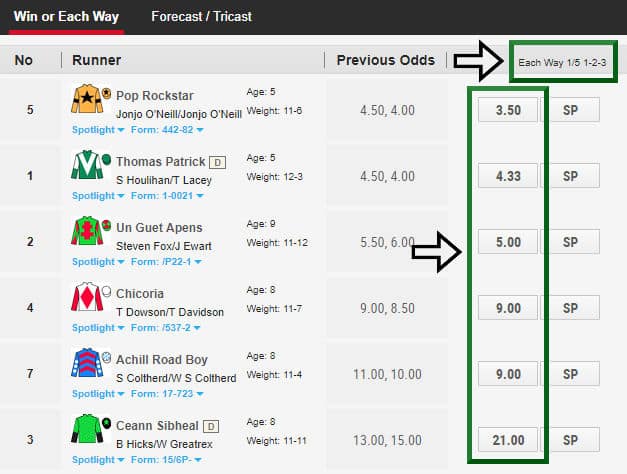What Does Each Way Mean In Tennis Betting
The betting odds on Tennis can vary so we would recommend using Oddschecker to check which bookmaker is giving the best Tennis odds for your Tennis bet or Tennis tip. Check out our Tennis bet of the day here. Check out our Tennis betting tips here. How does tennis scoring work. Tennis matches are made up of sets and games. Each player will. The Big Picture – Tennis Betting. Your equipment bag is now filled to the brim with all of the tools, tips, and strategies that you need to master the world of tennis betting. Does this mean that you’re going to start winning every single one of your bets immediately?
- Betting What Does +140 Mean
- What Does 150 Mean In Betting
- What Does Each Way Mean In Tennis Betting Results
- What Does Each Way Mean In Tennis Betting Odds
An each way bet is essentially two separate bets placed at the same time: a win bet and a place bet. For the win portion of the bet to payout the selection must win outright, while for the place portion of the bet to payout the selection must either win outright or finish in one of the ‘places’ outlined by the sportsbook. The number of ‘places’ that payout depends on the wager, so you should always make sure you check how many places pay rather than assuming its a certain number. The odds paid on the place portion of the bet are generally a fraction of the win odds. You will generally see 1/2, 1/4, etc and these fractions determine the odds that you will receive on the place portion of your bet.

For example at Bet365 you may see a bet that looks like this “Each-way 1/3 1-2-3”. This would mean that the place portion of the bet pays out 1/3 of the win odds which will be shown and the place bet wins if your selection finishes in the top 3 positions.
Each-way Bet Example
Here is an example of an each-way bet for the winner of the top goalscorer of the UEFA Champions League from Bet365.com.
Each-way 1/4 1-2-3-4
- Cristiano Ronaldo +150
- Lionel Messi +175
- Robin van Persie +800

There are the 3 favorites to win the top goalscorer in the Champions League this year. So let’s use Messi in this example and find out how much you would win based on which place he finishes in the top goalscorer standings. We will use a $100 each-way bet for this example, which would cost $200 total for the two bets it’s placing:
- The return on the win part of the bet (which is what the odds show) would be $100 stake + $175 winnings = $275
- The return on the place part of the bet (which is for finishing from 1st through 4th in this example) would be $100 stake + (175/4) = $143.75


So overall you bet $200 total, with $100 going towards the win portion of the bet and $100 going towards the place portion of the bet. If Messi won the scoring title outright then you would win both the win and place bets for a total payout of (275 + 143.75) = $418.75 (+$218.75). If Messi came 2nd through 4th you would lose the win portion of the bet, but win the place portion for a total payout of $143.75 (-$56.25). Then of course if Messi doesn’t finish in the top 4 at all you would lose your $200 bet.
Where Can Each-Way Bets Be Found
Each-way bets will be offered on any events where competitors finish in places. Some examples include horse racing, greyhounds, motor sports, golf, tennis tournaments (would typically be a 1-2 each way so the player would have to make the finals to payout on the place bet), and anything else where competitors are ranked.
Each-way Bet Tips
The main tip I can give you is to understand what you are betting on. Make sure you know how many places pay out and what the odds are for the place portion of the bet. As long as you have all of the information you can make an educated decision about whether or not you want to place the each-way bet.
If you are interested in tennis betting, it is important to know how to understand handicaps, where the difference in perceived abilities is balanced by applying a game handicap. These markets are a great alternative to the staple of tennis betting, the match winner market.

Understanding all available bet types is key to increasing profitability in tennis betting because you can choose the ideal option for the way you like to bet. The basic bet type in tennis is betting on the match winner. In this case, you bet on a tennis player to beat his opponent and move on to the next round.
Let’s take, for example, the 2016 Hunday Hopman Cup match between Murray and De Schepper. The British star won it in 2 sets with the final score 6:2 6:2. With Pinnacle’s closing odds for the match at 1.05 and 13.03 respectively, if you had placed a bet of $100 on Murray to win, you would have had a return of $105 with a net profit of $5.
Betting on big favourites like this, however, means very small returns for a proportionately high risk, which is where handicap betting comes into play.
Why handicaps are used in tennis betting
When a huge favourite plays against an underdog, the low odds can be unattractive to bettors, who don't see much value in tying up a part of their bankroll for a small potential reward.
To counter the difference in player’s abilities and level out the match, bookmakers offer handicap markets, which refer to the number of games each player is expected to win.
In this way, the chance of either player winning – pricing in the handicap-becomes as close to 50% as possible.
The handicap markets are valuable when betting on a match with a clear favourite, as the moneyline odds offer low reward-to-risk ratios.
Betting What Does +140 Mean
By betting on a handicap market, you are not predicting the actual winner, but rather how a player performs. As such, the handicap is factored into the final score to determine whether the bet is a winning one.
The handicap markets are valuable when betting on a match with a clear favourite. This can be achieved either by betting on the favorite with a negative handicap or on the outsider with a positive handicap.
In the Murray against De Schepper match for example, the main handicap was minus 5 games for the Brit and plus 5 games for the French player.
Positive and negative handicaps
In a match with handicap markets, the outsider receives a few games advantage, i.e. plus handicap, whereas the favourite receives a few games disadvantage, i.e. minus handicap, in order to counter the difference in quality.
The bets on the player who wins more games after the handicap has been applied, are winning bets, no matter which player ends up winning the match.
Let’s go back to the example of Murray vs De Schepper. Muzza took 6 games in the first set and 6 games in the second. De Schepper managed to win 2 games in the opening set and 2 more in the second. Summing it up, we get 12 games for Murray and 4 for his French counterpart.
A bet on Murray to win with the handicap set at -5 would be a winning one as 12 -5= 7, which is more than 4. The final score for the purposes of this bet is therefore 7:4, also referred to as “covering the handicap”. Conversely, a bet on De Schepper to win with the +5 handicap would be a losing one, as even with 5 extra games, De Schepper still loses 12-9.
What Does 150 Mean In Betting
With the Pinnacle odds at 1.775 on Murray to win with a -5 handicap, the return on a $100 bet in this case would be $177.5 with a net profit of $77.5, compared to just $5 on the match winner market.
Further benefits of handicap betting
Pinnacle offers the largest selection of handicap markets in the industry, allowing bettors interested in capitalizing on the advantages of handicap betting a large number of alternate handicaps.
To see the available handicap markets for a tennis match, login in to your Pinnacle account, go to the match of your preference and choose the handicap market you want to bet on from the drop down menu.
What Does Each Way Mean In Tennis Betting Results
Below is the example of the heavily tipped Wawrinka against underdog Rublev at the ATP Chennai. With the moneyline set at 1.108 and 8.170, the Pinnacle traders set the main handicap for this match at +/-5.
What Does Each Way Mean In Tennis Betting Odds
Apart from the main handicap, Pinnacle offered a number of plus and minus handicaps for the match, ranging from +/- 4 to +/- 6, allowing bettors to decide for themselves which handicap market offers the best value. You can either reduce the handicap (also known as buying) but receive inferior odds, or increase the handicap (selling) and thereby get a bigger return.
And last but not least, it is worth remembering that handicap markets allow the possibility of getting your bet refunded. In the case of whole numbers of games being used for handicap, as in the Murray vs De Schepper match, the final scoreline, considering the handicap, could result in a draw. In this scenario, all bets are cancelled and bettors get their original stake back.